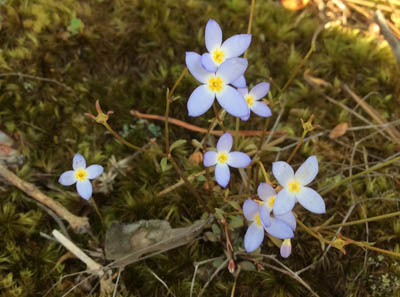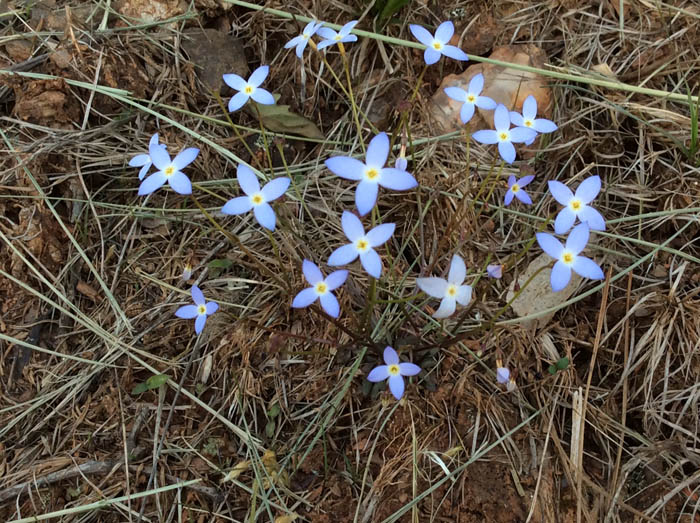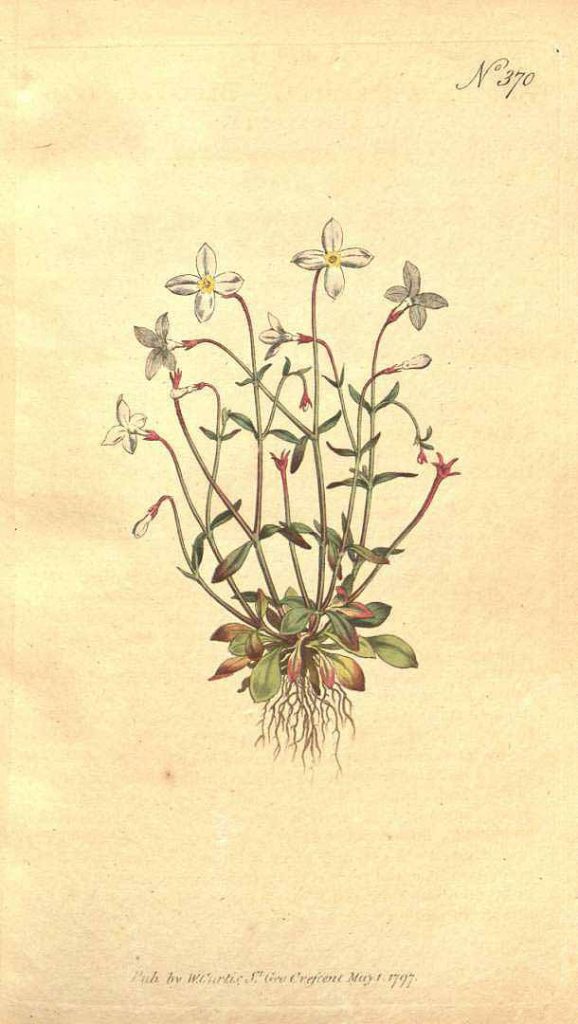
04.21.20 Blue Innocence
 “Innocence” suits these tiny blossoms, just a quarter-inch in diameter. This delicate beauty is unique to eastern North America. Two more names for Houstonia caerulea are Azure Bluets and Quaker Ladies. Quaker ladies seems most perfect to me because these flowers are always in motion. The blooms emerge at the end of tiny thread-like stalks just a couple of inches above the ground. The slightest breeze sends them into a fragile frenzy. There movement is perfectly choreographed, they dance together in perfect synchrony, a remarkable and memorable sight. But don’t touch, they are so small and fragile they will come apart in your fingers. Named caerulea for their cerulean blue color (derived from the Latin for “heaven” or “sky”), they are a wonderful instance of natural blue. Blue occurs infrequently in living things, and when it does is often very ephemeral. (Some of you know of my exciting search for a blue lobster in Maine several years ago, finally found in an aquarium in New Brunswick.) In fine oil painting, before the appearance of synthetic colors, a cherished blue pigment was ultramarine, obtained from lapis lazuli. A brilliant example of this color is in the head scarf of Vermeer’s Girl with a Pearl Earring.
“Innocence” suits these tiny blossoms, just a quarter-inch in diameter. This delicate beauty is unique to eastern North America. Two more names for Houstonia caerulea are Azure Bluets and Quaker Ladies. Quaker ladies seems most perfect to me because these flowers are always in motion. The blooms emerge at the end of tiny thread-like stalks just a couple of inches above the ground. The slightest breeze sends them into a fragile frenzy. There movement is perfectly choreographed, they dance together in perfect synchrony, a remarkable and memorable sight. But don’t touch, they are so small and fragile they will come apart in your fingers. Named caerulea for their cerulean blue color (derived from the Latin for “heaven” or “sky”), they are a wonderful instance of natural blue. Blue occurs infrequently in living things, and when it does is often very ephemeral. (Some of you know of my exciting search for a blue lobster in Maine several years ago, finally found in an aquarium in New Brunswick.) In fine oil painting, before the appearance of synthetic colors, a cherished blue pigment was ultramarine, obtained from lapis lazuli. A brilliant example of this color is in the head scarf of Vermeer’s Girl with a Pearl Earring.

Illustration from Curtis’ Botanical Magazine, 1797.
 Josef Beery
Josef Beery “Innocence” suits these tiny blossoms, just a quarter-inch in diameter. This delicate beauty is unique to eastern North America. Two more names for Houstonia caerulea are Azure Bluets and Quaker Ladies. Quaker ladies seems most perfect to me because these flowers are always in motion. The blooms emerge at the end of tiny thread-like stalks just a couple of inches above the ground. The slightest breeze sends them into a fragile frenzy. There movement is perfectly choreographed, they dance together in perfect synchrony, a remarkable and memorable sight. But don’t touch, they are so small and fragile they will come apart in your fingers. Named caerulea for their cerulean blue color (derived from the Latin for “heaven” or “sky”), they are a wonderful instance of natural blue. Blue occurs infrequently in living things, and when it does is often very ephemeral. (Some of you know of my exciting search for a blue lobster in Maine several years ago, finally found in an aquarium in New Brunswick.) In fine oil painting, before the appearance of synthetic colors, a cherished blue pigment was ultramarine, obtained from lapis lazuli. A brilliant example of this color is in the head scarf of Vermeer’s Girl with a Pearl Earring.
“Innocence” suits these tiny blossoms, just a quarter-inch in diameter. This delicate beauty is unique to eastern North America. Two more names for Houstonia caerulea are Azure Bluets and Quaker Ladies. Quaker ladies seems most perfect to me because these flowers are always in motion. The blooms emerge at the end of tiny thread-like stalks just a couple of inches above the ground. The slightest breeze sends them into a fragile frenzy. There movement is perfectly choreographed, they dance together in perfect synchrony, a remarkable and memorable sight. But don’t touch, they are so small and fragile they will come apart in your fingers. Named caerulea for their cerulean blue color (derived from the Latin for “heaven” or “sky”), they are a wonderful instance of natural blue. Blue occurs infrequently in living things, and when it does is often very ephemeral. (Some of you know of my exciting search for a blue lobster in Maine several years ago, finally found in an aquarium in New Brunswick.) In fine oil painting, before the appearance of synthetic colors, a cherished blue pigment was ultramarine, obtained from lapis lazuli. A brilliant example of this color is in the head scarf of Vermeer’s Girl with a Pearl Earring.